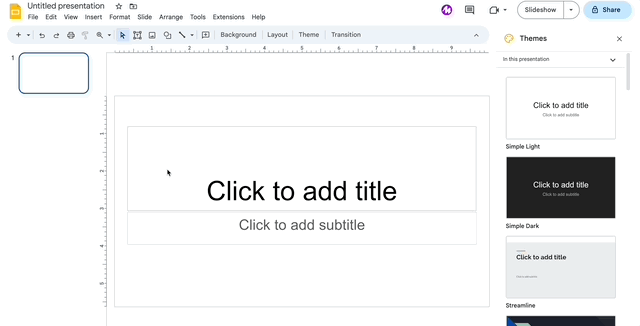Google Slides is a powerful tool that can be used by teachers to create engaging presentations, lesson plans, and assignments. One of the key features of Google Slides is the ability to change the slide size to suit different needs. In this blog post, we’ll discuss how to change the slide size and ideas for using alternate slide sizes for lessons and projects.
To change the slide size in Google Slides, follow these steps:
- Open the Google Slides presentation that you want to change the slide size for.
- Click on the File menu.
- Select Page setup.
- In the Slide size section, select the desired slide size from the drop-down menu. Note: Custom allows you to change the size to any dimension you choose. (i.e. 8×11 for notebook size)
- Click on the Apply button.
- Click on the OK button.

My favorite thing to do in Google Slides is to allow students to create “books.” When slide size is set to 8.5 inches by 11 inches, the page mimics the size of a typical piece of paper. Students can then enter content on the slides as they would the pages of a book. They can even create a table of contents and link to each slide from there.
Once students have finished their final draft, have them save the slide show as a pdf. When viewed as a pdf, the slides look like a scanned book.
Pro-Tip: Create QR codes with the links from the pdf versions, put the QR codes on the wall for Open House and allow families to see their child’s book.
What are some additional reasons you might want to change the size of a slide?
Printable handouts: If you want to create a handout that students can print out, you can change the slide size to match the dimensions of a piece of paper. For example, you could change the slide size to 8.5 x 11 inches to create a handout that students can print out on standard printer paper.
Interactive whiteboard presentations: If you plan on using Google Slides on an interactive whiteboard, you may want to change the slide size to match the dimensions of the whiteboard. For example, if you have a 60-inch interactive whiteboard, you could change the slide size to 1200 x 800 pixels.
Video presentations: If you plan on creating a video presentation, you may want to change the slide size to match the dimensions of the video output. For example, if you plan on uploading your presentation to YouTube, you could change the slide size to 1920 x 1080 pixels.
Finally, how about some other fun ways to use Slides in your classroom:
Interactive presentations: Teachers can create interactive presentations using Google Slides by adding links, videos, and quizzes. These presentations can be used to introduce new concepts or review previously taught material.
Collaborative projects: Google Slides can be used for collaborative projects such as group presentations, research projects, or group assignments. Students can work together on the same slide deck in real-time, making it easy to collaborate and share ideas.
Interactive notebooks: Teachers can create interactive notebooks for students using Google Slides. Students can take notes, add images, and videos to their slides, making it easy to review and study for exams.
Vocabulary practice: Teachers can create vocabulary practice activities using Google Slides. Students can match words with definitions, use words in sentences, or create their own definitions for words. Slides are great for Frayer Models!
Digital posters: Students can use Google Slides to create digital posters on a variety of topics. They can add images, text, and videos to their slides to create an engaging and informative poster.
Virtual field trips: Teachers can use Google Slides to take students on virtual field trips. They can create a slide deck with images and information about a particular location, allowing students to explore and learn about new places.
Storytelling: Google Slides can be used for storytelling activities. Students can create a slide deck with images and text to tell a story or write a narrative.
Digital portfolios: Teachers can use Google Slides to create digital portfolios for students. Students can add their work, such as essays, artwork, and projects to their portfolios, making it easy to showcase their achievements.

